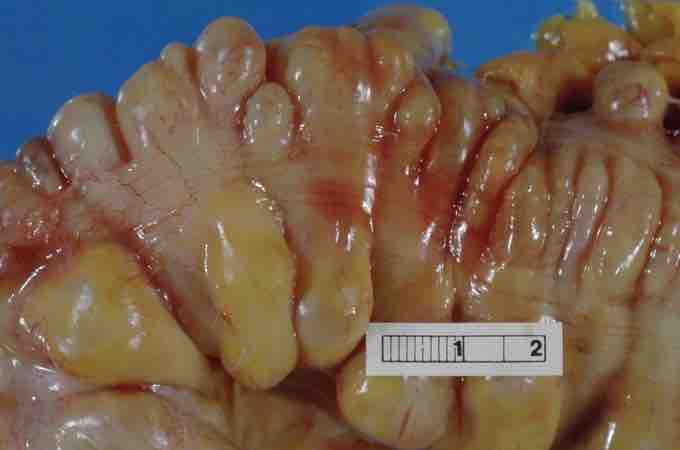The large intestine, or large bowel, is the last part of the digestive system in vertebrate animals. Its function is to absorb water from the remaining indigestible food matter, and then to pass useless waste material from the body. The large intestine consists of the cecum, colon, rectum, and anal canal. It starts in the right iliac region of the pelvis, just at or below the right waist, where it is joined to the bottom end of the small intestine. From here it continues up the abdomen, across the width of the abdominal cavity, and then it turns downward, continuing to its endpoint at the anus.
The large intestine differs in physical form from the small intestine in being much wider. The longitudinal layer of the muscularis is reduced to three strap-like structures known as the taeniae coli , bands of longitudinal muscle fibers, each about 1/5 in wide. These three bands start at the base of the appendix and extend from the cecum to the rectum. Along the sides of the taeniae, tags of peritoneum filled with fat, called epiploic appendages, or appendices epiploicae, are found. The wall of the large intestine is lined with simple columnar epithelium. Instead of having the evaginations of the small intestine (villi), the large intestine has invaginations (the intestinal glands) . While both the small intestine and the large intestine have goblet cells (secrete mucin to form mucus in water), they are abundant in the large intestine.

Colon Biopsy
Micrograph of a colon biopsy.

Sigmoid Colon
Large bowel (sigmoid colon) showing multiple diverticula on either side of the longitudinal muscle bundle (Taenia coli).
In histology, an intestinal crypt, also crypt of Lieberkühn and intestinal gland, is a gland found in the epithelial lining of the small intestine and colon. The crypts and intestinal villi are covered by epithelium which contains two types of cells, goblet cells (secreting mucus) and enterocytes (secreting water and electrolytes).
The enterocytes in the mucosa contain digestive enzymes that digest specific food while they are being absorbed through the epithelium. These enzymes include peptidases, sucrase, maltase, lactase and intestinal lipase. This is in contrast to the stomach, where chief cells secrete pepsinogen. In the intestine the aforementioned digestive enzymes are not secreted by the cells of the intestine.
Also, new epithelium is formed here, which is important because the cells at this site are continuously worn away by the passing food. The basal, further from the intestinal lumen, portion of the crypt contains multipotent stem cells. During each mitosis, one of the two daughter cells remains in the crypt as a stem cell, while the other differentiates and migrates up the side of the crypt and eventually into the villus. Goblet cells are among the cells produced in this fashion. Many genes have been shown to be important for the differentiation of intestinal stem cells.
Loss of proliferation control in the crypts is thought to lead to colorectal cancer.